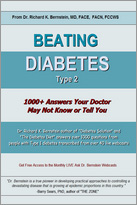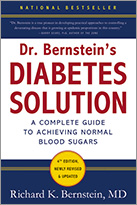by Rick Mendosa
Mendosa.com
March 2000
Diabetes Wellness Letter
The ability for people with diabetes to test their own blood glucose is probably the most important advance in controlling diabetes since the discovery of insulin in 1921-22. Only the introduction of the first oral medications for diabetes in 1955 could rival the invention of blood glucose meters.
Yet few of us know anything about how self-testing of blood glucose began, and many of us take our blood glucose meters for granted. It’s not uncommon to hear people refer to getting a meter as a “new toy.”
Considering how inexpensive and commonplace blood glucose monitors have become, that’s understandable. But toys they are not. It’s taken years for us to get to where we are now with fast, easy-to-use, and accurate meters.
It has taken, in fact, more than three decades. It was not in 1980 that blood glucose meters were invented, as Deb Butterfield’s otherwise great book, Showdown with Diabetes (Norton, 1999), implies. She writes that Dr. Michael Miller met the venture capitalist Ted Doan at a cocktail party and convinced him to develop a blood glucose monitor.
Dr. Miller, still in practice as an endocrinologist in Midland, Michigan, confirms that the 1980 meeting took place as described in the book. That meeting led them to found LifeScan, which went on to dominate the meter market after Johnson & Johnson bought the company in 1986.
But as important as the meeting was from a marketing standpoint, they did not develop the first blood glucose meters. “I can’t claim it as my idea in any way, because I had read about it in Diabetes Care, which had just started,” Dr. Miller told me.
The article that Dr. Miller read was undoubtedly one that someone wrote describing Dick Bernstein’s method of controlling blood glucose, which included frequent testing. Bernstein was an engineer who has had type 1 diabetes ever since he was a teen-ager.
“One of the main reasons why I started all the blood sugar measurements was all the hypoglycemia,” Bernstein now says. “My family was mad at me. I made them terrified.”
He had started testing his blood a decade earlier. He recalls how his life turned around in October 1969 when he happened to read an ad in a technical magazine for a blood sugar meter that would give a reading in 1 minute using a single drop of blood. It weighted 3 pounds and cost $650, a month’s salary in those days.
That was bad enough, but the real kicker is that the company that made the meter refused to sell it to patients. Fortunately for Bernstein, his wife was a psychiatrist, so he ordered it in her name and got it in January 1970, he recalls. It wasn’t until the late 1970s that patients could buy meters without a prescription.
Testing 5 to 8 times a day, going from one to two daily injections of insulin, and changing his diet finally gave him normal blood glucose readings. Reversing most of the complications of diabetes that had afflicted him, Bernstein wanted to share his results.
But his doctor told him, “it’s impossible to normalize human blood sugars.” The articles he read in diabetes journals all said the same thing.
“So I wrote an article detailing my discoveries,” Bernstein recalls. He says that the only encouragement he got was from Charles Suther, who was then marketing manager for diabetes products at Ames Company, a division of Miles Laboratories in Elkhart, Indiana, which made the meter he used. Suther is now a self-employed consultant in Indianapolis, and the company is now part of Bayer Corp.
Suther arranged for a medical writer at Ames to edit Bernstein’s article. But still he couldn’t get published. He says that’s why in 1979 at age 45 he went to medical school to become an endocrinologist. He is the author of Dr. Bernstein’s Diabetes Solution (Little, Brown, 1997), two earlier books on diabetes, and dozens of journal articles.
The first blood glucose meter and the first one that Bernstein used was the Ames Reflectance Meter, abbreviated as the A.R.M. Further, he was the first patient to use it.
“Shortly after the introduction of the A.R.M. in 1969,” Suther recalls, “while I was working at Ames, I got a phone call from a guy by the name of Dick Bernstein. To our best record he was the first individual to test his blood sugar.”
The A.R.M. used Dextrostix, which were paper strips to which you added a drop of blood, timed it for 1 minute, and washed it off. They developed a blue color, and you read that color by comparing it to a color chart. They were not quantative, but gave an approximation of your blood glucose level. They were designed primarily for doctor’s offices and were hard to read accurately.
Ernest C. Adams, who was then employed by Ames R&D, invented Dextrostix in the early 1960s. Bayer says that they were they discontinued two or three years ago.
“Realizing that the Dextrostix were difficult to use,” Suther says, “one of the engineers developed a reflectance meter. That is, one that could read reflected light.”
Who was that engineer? “Anton H. (Tom) Clemens,” Suther replies. “His meter used the same Dextrostix. The reflected light was sent to a photoelectric cell, which gave a numerical read out with a swinging needle.”
Tom Clemens, the inventor of the first blood glucose meter, started working on it in 1966, built several prototypes for field trials in 1968, and filed a patent application in April of that year. The patent, number 3,604,815, was issued on September 14, 1971, about two years after it went on the market.
The delay in getting a patent was not unusual. But his company — and indeed the entire diabetes establishment — was slow to appreciate the importance of the meter. “Initially, the only one to side with it was Charlie Suther,” says Clemens, who is now a self-employed consultant in Madison, Wisconsin.
“The Reflectance Meter became a hobby of mine, which marketing really didn’t want to have any part of,” Clemens recalls. “We had the Reflectance Meter done — prototypes ready for evaluation — and were still waiting for the approval of the project.”
Clemens eventually got the meter approved. At the time he headed the Ames Instrument R&D Department. Dr. Joe Kopp gave him medical advice and support, and Ken Collister’s ergonomic industrial design emphasized simplicity of operation by non-professional persons, which indicates that they were thinking about patient self-testing all along.
Did Clemens ever imagine that blood glucose meters would ever be such a big business? “No, not in the dimension that it turned out,” he replies. “However, it was clear to me right from the beginning that this is a niche that will blossom.”
The Ames Reflectance Meter quickly led to the Eyetone, made by Kyoto Daiichi Kagaku Company in Japan but sold by Ames. The third meter, also made by Koyoto Daiichi and sold by Ames, was called the Ames Glucometer.
Many meters followed, and currently nine companies offer 30 different models in the United States alone. The U.S. market for blood glucose self-monitoring supplies exceeds $1 billion, according to the Frost & Sullivan market research firm. Worldwide it is more than $3 billion. And for millions of people these meters are the keystone to controlling their diabetes.




